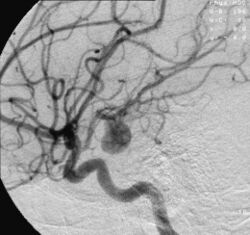Aneurysm
(Disease) | |
|---|---|
 Angiography of an aneurysm in a brain artery. The aneurysm is the large bulge in the center of the image. | |
| An outward bulging, likened to a bubble or balloon, caused by a localized, abnormal, weak spot on a blood vessel. |
An aneurysm is an outward bulging, likened to a bubble or balloon, caused by a localized, abnormal, weak spot on a blood vessel wall.[1] Aneurysms may be a result of a hereditary condition or an acquired disease. Aneurysms can also be a starting point for clot formation (thrombosis) and embolization. As an aneurysm increases in size, the risk of rupture increases,[2] leading to uncontrolled bleeding. Although they may occur in any blood vessel, particularly lethal examples include aneurysms of the Circle of Willis in the brain, aortic aneurysms affecting the thoracic aorta, and abdominal aortic aneurysms. Aneurysms can arise in the heart itself following a heart attack, including both ventricular and atrial septal aneurysms. There are congenital atrial septal aneurysms, a rare heart defect.
Aneurysm can either be congenital, cause by external force or be caused by disease, including atherosclerosis and syphilis. Aneurysms can cause pain by pressing on nerve roots, causing vocal cord paralysis and even leading to impaired blood circulation.
References
- ↑ https://www.nhlbi.nih.gov/health-topics/aneurysm
- ↑ Cronenwett JL, Murphy TF, Zelenock GB, Whitehouse WM, Lindenauer SM, Graham LM, Quint LE, Silver TM, Stanley JC (September 1985). "Actuarial analysis of variables associated with rupture of small abdominal aortic aneurysms". Surgery. 98 (3): 472–83